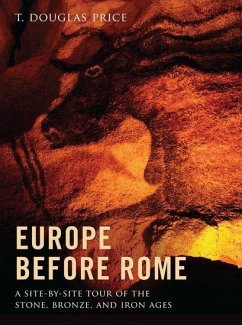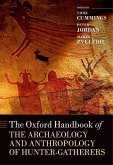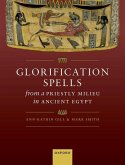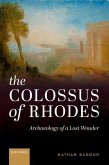- Gebundenes Buch
- Merkliste
- Auf die Merkliste
- Bewerten Bewerten
- Teilen
- Produkt teilen
- Produkterinnerung
- Produkterinnerung
Europe before Rome uses the extraordinary archaeology of prehistoric Europe to explore questions about the origins and evolution of human society
Andere Kunden interessierten sich auch für
![The Oxford Handbook of the Archaeology and Anthropology of Hunter-Gatherers The Oxford Handbook of the Archaeology and Anthropology of Hunter-Gatherers]() The Oxford Handbook of the Archaeology and Anthropology of Hunter-Gatherers277,99 €
The Oxford Handbook of the Archaeology and Anthropology of Hunter-Gatherers277,99 €![Glorification Spells from a Priestly Milieu in Ancient Egypt Glorification Spells from a Priestly Milieu in Ancient Egypt]() Ann-Katrin GillGlorification Spells from a Priestly Milieu in Ancient Egypt317,99 €
Ann-Katrin GillGlorification Spells from a Priestly Milieu in Ancient Egypt317,99 €![The Colossus of Rhodes The Colossus of Rhodes]() Nathan BadoudThe Colossus of Rhodes120,99 €
Nathan BadoudThe Colossus of Rhodes120,99 €![The Human Factor The Human Factor]() Alejandro SinnerThe Human Factor185,99 €
Alejandro SinnerThe Human Factor185,99 €![The Oxford History of the Ancient Near East The Oxford History of the Ancient Near East]() The Oxford History of the Ancient Near East183,99 €
The Oxford History of the Ancient Near East183,99 €![Nomadism in Iran Nomadism in Iran]() Daniel T PottsNomadism in Iran184,99 €
Daniel T PottsNomadism in Iran184,99 €![The Lives of Prehistoric Monuments in Iron Age, Roman, and Medieval Europe The Lives of Prehistoric Monuments in Iron Age, Roman, and Medieval Europe]() The Lives of Prehistoric Monuments in Iron Age, Roman, and Medieval Europe142,99 €
The Lives of Prehistoric Monuments in Iron Age, Roman, and Medieval Europe142,99 €-
-
-
Europe before Rome uses the extraordinary archaeology of prehistoric Europe to explore questions about the origins and evolution of human society
Hinweis: Dieser Artikel kann nur an eine deutsche Lieferadresse ausgeliefert werden.
Hinweis: Dieser Artikel kann nur an eine deutsche Lieferadresse ausgeliefert werden.
Produktdetails
- Produktdetails
- Verlag: Oxford University Press
- Seitenzahl: 424
- Erscheinungstermin: 9. Januar 2013
- Englisch
- Abmessung: 261mm x 203mm x 30mm
- Gewicht: 1150g
- ISBN-13: 9780199914708
- ISBN-10: 0199914702
- Artikelnr.: 36197915
- Herstellerkennzeichnung
- Libri GmbH
- Europaallee 1
- 36244 Bad Hersfeld
- gpsr@libri.de
- Verlag: Oxford University Press
- Seitenzahl: 424
- Erscheinungstermin: 9. Januar 2013
- Englisch
- Abmessung: 261mm x 203mm x 30mm
- Gewicht: 1150g
- ISBN-13: 9780199914708
- ISBN-10: 0199914702
- Artikelnr.: 36197915
- Herstellerkennzeichnung
- Libri GmbH
- Europaallee 1
- 36244 Bad Hersfeld
- gpsr@libri.de
T. Douglas Price is Weinstein Professor of European Archaeology Emeritus at the University of Wisconsin-Madison. His books include Images of the Past, Europe's First Farmers, and the leading introductory textbook in the discipline, Principles of Archaeology.
* Preface * Chapter 1. Frameworks for Europe's Past * Geography and Environment * Geology * Raw Materials * Past Climates * Time and Chronology * A Very Short History of European Archaeology * Chapter 2. The First Europeans * Early Europeans * Atapuerca
Spain
1
300
000 year ago * Boxgrove
England
UK
500
000 years ago * Schöningen
Germany
400
000 years ago * Neanderthals * Krapina
Croatia
130
000 years ago * Salzgitter-Lebenstedt
Germany
55
000 years ago * El Sidrón
Spain
43
000 years ago * Grotte du Renne
France
40
000 years ago * Vindija Cave
Croatia
34
000 years ago * Ancient DNA * Neanderthal Diet * Some Reflections * Chapter 3. The Creative Explosion * Origin and Spread of Modern Humans * The Upper Paleolithic * Pestera cu Oase
Romania
40
000 years ago * Grotte Chauvet
France
32
000 years ago * Grande Grotte
France
32
000 years ago * Dolní V?stonice
Czech Republic
27
500 years ago * Grotte de la Vache
France
14
000 years ago * Gönnersdorf
Germany
11
500 years ago * Pincevent
France
12
000 years ago * Doggerland
North Sea
11
000 BC * The Last Hunters * Franchthi Cave
Greece
9000 BC * Mount Sandel
Ireland
7000 BC * Moita do Sebastaio
Portugal
6000 BC * Polderveg
Netherlands
5500 BC * Tybrind Vig
Denmark
5000 BC * Vedbæk
Denmark
5000 BC * Rock Art: Vingen
Norway
5000 BC * Some Reflections * Chapter 4. The First Farmers * The Origins and Spread of Agriculture * Shillourokambos
Cyprus
8200 BC * Nea Nikomedeia
Greece
6200 BC * Lepenski Vir
Serbia
6200 BC * Vinca
Serbia
5500 BC * Rudna Glava
Serbia
5000 BC * Varna
Bulgaria
4500 BC * Passo di Corvo
Italy
6000 BC * Linearbandkeramik * Vaihingen
Germany
5300 BC * Polished Flint Axes * Spiennes
Belgium
4400 BC * La Draga
Spain
5000 BCArbon Bleich
Switzerland
3384 BC * Ötzi
Italy
3300 BC * The Megaliths of Western Europe * Skara Brae
Orkney Islands
UK
3200 BC * Stonehenge
UK
3100 BC * Newgrange
Ireland
3100 BC * Los Millares
Spain
3200 BC * Hal Saflieni
Malta
3600 BC * Rock Art: Barranco de la Valtort
Spain
5500 BC * Some Reflections * Chapter 5. Bronze Age Warriors * The Rise of Metals * The Bronze Age in the Aegean * Knossos
Crete
Greece
3000 BC * Akrotiri
Greece
1627 BC * Mykene
Greece
1600 BC * Uluburun
Turkey
1300 BC * The Bronze Age North of the Alps * Bell Beaker * Amesbury Archer
UK
2470 BC * The Indo-Europeans * Croce del Papa
Italy
2150 BC * Poggiomarino
Italy
1600 BC * Nebra
Germany
1600 BC * Bronze Age Finds * Sun Chariot
Denmark
1400 BC * Bronze Lurs
Denmark
Sweden
ca. 1000 BC * Gold Hats
Germany
ca. 1000 BC * Flag Fen
UK
1350 BC * Salcombe
UK
1000 BC * Rock Art: Tanum
Sweden
1500 BC * Some Reflections * Chapter 6. Centers of Power
Weapons of Iron * At the Edge of History * The Celts * The Germans * The Scythians * Making Iron * Biskupin
Poland
738 BC * The Etruscans * Necropoli della Banditaccia
Italy
650 BC * Hallstatt
Austria
800 BC * Hochdorf
Germany
530 BC * Vix
France 480 BC * Danebury
UK
550 BC * Grauballe
Denmark
300 BC * Manching
Germany
300 BC * Gournay-sur-Aronde
France
280 BC * Ribemont-sur-Ancre
France
260 BC * Celtic Religion * Maiden Castle
UK
43 BC * Some Reflections * An Epilogue. Past and Present - Lessons from Prehistoric Europe * Europe before Rome * Significance * Relevance * Preservation * Appreciation * References * Credits * Index
Spain
1
300
000 year ago * Boxgrove
England
UK
500
000 years ago * Schöningen
Germany
400
000 years ago * Neanderthals * Krapina
Croatia
130
000 years ago * Salzgitter-Lebenstedt
Germany
55
000 years ago * El Sidrón
Spain
43
000 years ago * Grotte du Renne
France
40
000 years ago * Vindija Cave
Croatia
34
000 years ago * Ancient DNA * Neanderthal Diet * Some Reflections * Chapter 3. The Creative Explosion * Origin and Spread of Modern Humans * The Upper Paleolithic * Pestera cu Oase
Romania
40
000 years ago * Grotte Chauvet
France
32
000 years ago * Grande Grotte
France
32
000 years ago * Dolní V?stonice
Czech Republic
27
500 years ago * Grotte de la Vache
France
14
000 years ago * Gönnersdorf
Germany
11
500 years ago * Pincevent
France
12
000 years ago * Doggerland
North Sea
11
000 BC * The Last Hunters * Franchthi Cave
Greece
9000 BC * Mount Sandel
Ireland
7000 BC * Moita do Sebastaio
Portugal
6000 BC * Polderveg
Netherlands
5500 BC * Tybrind Vig
Denmark
5000 BC * Vedbæk
Denmark
5000 BC * Rock Art: Vingen
Norway
5000 BC * Some Reflections * Chapter 4. The First Farmers * The Origins and Spread of Agriculture * Shillourokambos
Cyprus
8200 BC * Nea Nikomedeia
Greece
6200 BC * Lepenski Vir
Serbia
6200 BC * Vinca
Serbia
5500 BC * Rudna Glava
Serbia
5000 BC * Varna
Bulgaria
4500 BC * Passo di Corvo
Italy
6000 BC * Linearbandkeramik * Vaihingen
Germany
5300 BC * Polished Flint Axes * Spiennes
Belgium
4400 BC * La Draga
Spain
5000 BCArbon Bleich
Switzerland
3384 BC * Ötzi
Italy
3300 BC * The Megaliths of Western Europe * Skara Brae
Orkney Islands
UK
3200 BC * Stonehenge
UK
3100 BC * Newgrange
Ireland
3100 BC * Los Millares
Spain
3200 BC * Hal Saflieni
Malta
3600 BC * Rock Art: Barranco de la Valtort
Spain
5500 BC * Some Reflections * Chapter 5. Bronze Age Warriors * The Rise of Metals * The Bronze Age in the Aegean * Knossos
Crete
Greece
3000 BC * Akrotiri
Greece
1627 BC * Mykene
Greece
1600 BC * Uluburun
Turkey
1300 BC * The Bronze Age North of the Alps * Bell Beaker * Amesbury Archer
UK
2470 BC * The Indo-Europeans * Croce del Papa
Italy
2150 BC * Poggiomarino
Italy
1600 BC * Nebra
Germany
1600 BC * Bronze Age Finds * Sun Chariot
Denmark
1400 BC * Bronze Lurs
Denmark
Sweden
ca. 1000 BC * Gold Hats
Germany
ca. 1000 BC * Flag Fen
UK
1350 BC * Salcombe
UK
1000 BC * Rock Art: Tanum
Sweden
1500 BC * Some Reflections * Chapter 6. Centers of Power
Weapons of Iron * At the Edge of History * The Celts * The Germans * The Scythians * Making Iron * Biskupin
Poland
738 BC * The Etruscans * Necropoli della Banditaccia
Italy
650 BC * Hallstatt
Austria
800 BC * Hochdorf
Germany
530 BC * Vix
France 480 BC * Danebury
UK
550 BC * Grauballe
Denmark
300 BC * Manching
Germany
300 BC * Gournay-sur-Aronde
France
280 BC * Ribemont-sur-Ancre
France
260 BC * Celtic Religion * Maiden Castle
UK
43 BC * Some Reflections * An Epilogue. Past and Present - Lessons from Prehistoric Europe * Europe before Rome * Significance * Relevance * Preservation * Appreciation * References * Credits * Index
* Preface * Chapter 1. Frameworks for Europe's Past * Geography and Environment * Geology * Raw Materials * Past Climates * Time and Chronology * A Very Short History of European Archaeology * Chapter 2. The First Europeans * Early Europeans * Atapuerca
Spain
1
300
000 year ago * Boxgrove
England
UK
500
000 years ago * Schöningen
Germany
400
000 years ago * Neanderthals * Krapina
Croatia
130
000 years ago * Salzgitter-Lebenstedt
Germany
55
000 years ago * El Sidrón
Spain
43
000 years ago * Grotte du Renne
France
40
000 years ago * Vindija Cave
Croatia
34
000 years ago * Ancient DNA * Neanderthal Diet * Some Reflections * Chapter 3. The Creative Explosion * Origin and Spread of Modern Humans * The Upper Paleolithic * Pestera cu Oase
Romania
40
000 years ago * Grotte Chauvet
France
32
000 years ago * Grande Grotte
France
32
000 years ago * Dolní V?stonice
Czech Republic
27
500 years ago * Grotte de la Vache
France
14
000 years ago * Gönnersdorf
Germany
11
500 years ago * Pincevent
France
12
000 years ago * Doggerland
North Sea
11
000 BC * The Last Hunters * Franchthi Cave
Greece
9000 BC * Mount Sandel
Ireland
7000 BC * Moita do Sebastaio
Portugal
6000 BC * Polderveg
Netherlands
5500 BC * Tybrind Vig
Denmark
5000 BC * Vedbæk
Denmark
5000 BC * Rock Art: Vingen
Norway
5000 BC * Some Reflections * Chapter 4. The First Farmers * The Origins and Spread of Agriculture * Shillourokambos
Cyprus
8200 BC * Nea Nikomedeia
Greece
6200 BC * Lepenski Vir
Serbia
6200 BC * Vinca
Serbia
5500 BC * Rudna Glava
Serbia
5000 BC * Varna
Bulgaria
4500 BC * Passo di Corvo
Italy
6000 BC * Linearbandkeramik * Vaihingen
Germany
5300 BC * Polished Flint Axes * Spiennes
Belgium
4400 BC * La Draga
Spain
5000 BCArbon Bleich
Switzerland
3384 BC * Ötzi
Italy
3300 BC * The Megaliths of Western Europe * Skara Brae
Orkney Islands
UK
3200 BC * Stonehenge
UK
3100 BC * Newgrange
Ireland
3100 BC * Los Millares
Spain
3200 BC * Hal Saflieni
Malta
3600 BC * Rock Art: Barranco de la Valtort
Spain
5500 BC * Some Reflections * Chapter 5. Bronze Age Warriors * The Rise of Metals * The Bronze Age in the Aegean * Knossos
Crete
Greece
3000 BC * Akrotiri
Greece
1627 BC * Mykene
Greece
1600 BC * Uluburun
Turkey
1300 BC * The Bronze Age North of the Alps * Bell Beaker * Amesbury Archer
UK
2470 BC * The Indo-Europeans * Croce del Papa
Italy
2150 BC * Poggiomarino
Italy
1600 BC * Nebra
Germany
1600 BC * Bronze Age Finds * Sun Chariot
Denmark
1400 BC * Bronze Lurs
Denmark
Sweden
ca. 1000 BC * Gold Hats
Germany
ca. 1000 BC * Flag Fen
UK
1350 BC * Salcombe
UK
1000 BC * Rock Art: Tanum
Sweden
1500 BC * Some Reflections * Chapter 6. Centers of Power
Weapons of Iron * At the Edge of History * The Celts * The Germans * The Scythians * Making Iron * Biskupin
Poland
738 BC * The Etruscans * Necropoli della Banditaccia
Italy
650 BC * Hallstatt
Austria
800 BC * Hochdorf
Germany
530 BC * Vix
France 480 BC * Danebury
UK
550 BC * Grauballe
Denmark
300 BC * Manching
Germany
300 BC * Gournay-sur-Aronde
France
280 BC * Ribemont-sur-Ancre
France
260 BC * Celtic Religion * Maiden Castle
UK
43 BC * Some Reflections * An Epilogue. Past and Present - Lessons from Prehistoric Europe * Europe before Rome * Significance * Relevance * Preservation * Appreciation * References * Credits * Index
Spain
1
300
000 year ago * Boxgrove
England
UK
500
000 years ago * Schöningen
Germany
400
000 years ago * Neanderthals * Krapina
Croatia
130
000 years ago * Salzgitter-Lebenstedt
Germany
55
000 years ago * El Sidrón
Spain
43
000 years ago * Grotte du Renne
France
40
000 years ago * Vindija Cave
Croatia
34
000 years ago * Ancient DNA * Neanderthal Diet * Some Reflections * Chapter 3. The Creative Explosion * Origin and Spread of Modern Humans * The Upper Paleolithic * Pestera cu Oase
Romania
40
000 years ago * Grotte Chauvet
France
32
000 years ago * Grande Grotte
France
32
000 years ago * Dolní V?stonice
Czech Republic
27
500 years ago * Grotte de la Vache
France
14
000 years ago * Gönnersdorf
Germany
11
500 years ago * Pincevent
France
12
000 years ago * Doggerland
North Sea
11
000 BC * The Last Hunters * Franchthi Cave
Greece
9000 BC * Mount Sandel
Ireland
7000 BC * Moita do Sebastaio
Portugal
6000 BC * Polderveg
Netherlands
5500 BC * Tybrind Vig
Denmark
5000 BC * Vedbæk
Denmark
5000 BC * Rock Art: Vingen
Norway
5000 BC * Some Reflections * Chapter 4. The First Farmers * The Origins and Spread of Agriculture * Shillourokambos
Cyprus
8200 BC * Nea Nikomedeia
Greece
6200 BC * Lepenski Vir
Serbia
6200 BC * Vinca
Serbia
5500 BC * Rudna Glava
Serbia
5000 BC * Varna
Bulgaria
4500 BC * Passo di Corvo
Italy
6000 BC * Linearbandkeramik * Vaihingen
Germany
5300 BC * Polished Flint Axes * Spiennes
Belgium
4400 BC * La Draga
Spain
5000 BCArbon Bleich
Switzerland
3384 BC * Ötzi
Italy
3300 BC * The Megaliths of Western Europe * Skara Brae
Orkney Islands
UK
3200 BC * Stonehenge
UK
3100 BC * Newgrange
Ireland
3100 BC * Los Millares
Spain
3200 BC * Hal Saflieni
Malta
3600 BC * Rock Art: Barranco de la Valtort
Spain
5500 BC * Some Reflections * Chapter 5. Bronze Age Warriors * The Rise of Metals * The Bronze Age in the Aegean * Knossos
Crete
Greece
3000 BC * Akrotiri
Greece
1627 BC * Mykene
Greece
1600 BC * Uluburun
Turkey
1300 BC * The Bronze Age North of the Alps * Bell Beaker * Amesbury Archer
UK
2470 BC * The Indo-Europeans * Croce del Papa
Italy
2150 BC * Poggiomarino
Italy
1600 BC * Nebra
Germany
1600 BC * Bronze Age Finds * Sun Chariot
Denmark
1400 BC * Bronze Lurs
Denmark
Sweden
ca. 1000 BC * Gold Hats
Germany
ca. 1000 BC * Flag Fen
UK
1350 BC * Salcombe
UK
1000 BC * Rock Art: Tanum
Sweden
1500 BC * Some Reflections * Chapter 6. Centers of Power
Weapons of Iron * At the Edge of History * The Celts * The Germans * The Scythians * Making Iron * Biskupin
Poland
738 BC * The Etruscans * Necropoli della Banditaccia
Italy
650 BC * Hallstatt
Austria
800 BC * Hochdorf
Germany
530 BC * Vix
France 480 BC * Danebury
UK
550 BC * Grauballe
Denmark
300 BC * Manching
Germany
300 BC * Gournay-sur-Aronde
France
280 BC * Ribemont-sur-Ancre
France
260 BC * Celtic Religion * Maiden Castle
UK
43 BC * Some Reflections * An Epilogue. Past and Present - Lessons from Prehistoric Europe * Europe before Rome * Significance * Relevance * Preservation * Appreciation * References * Credits * Index








